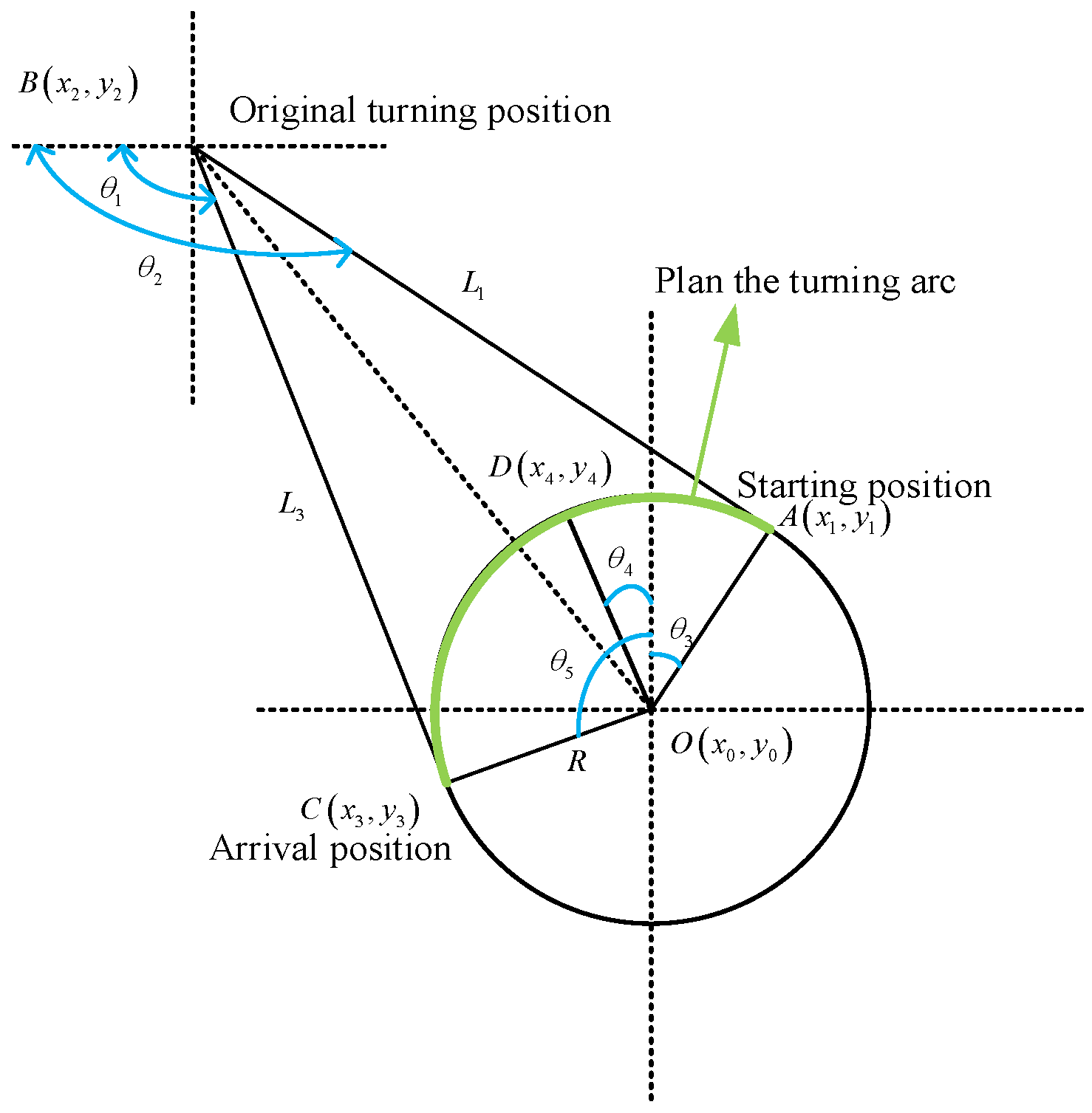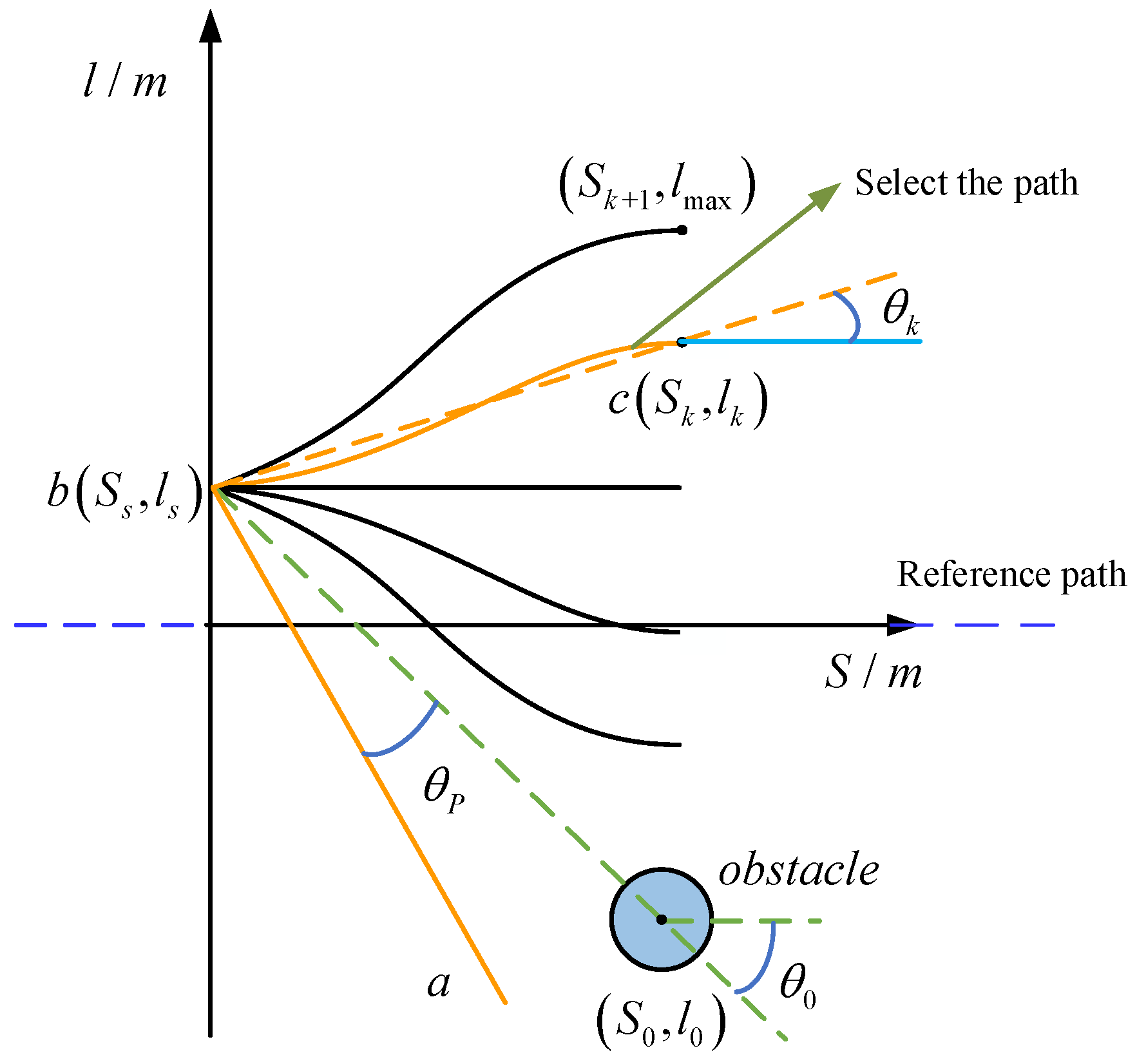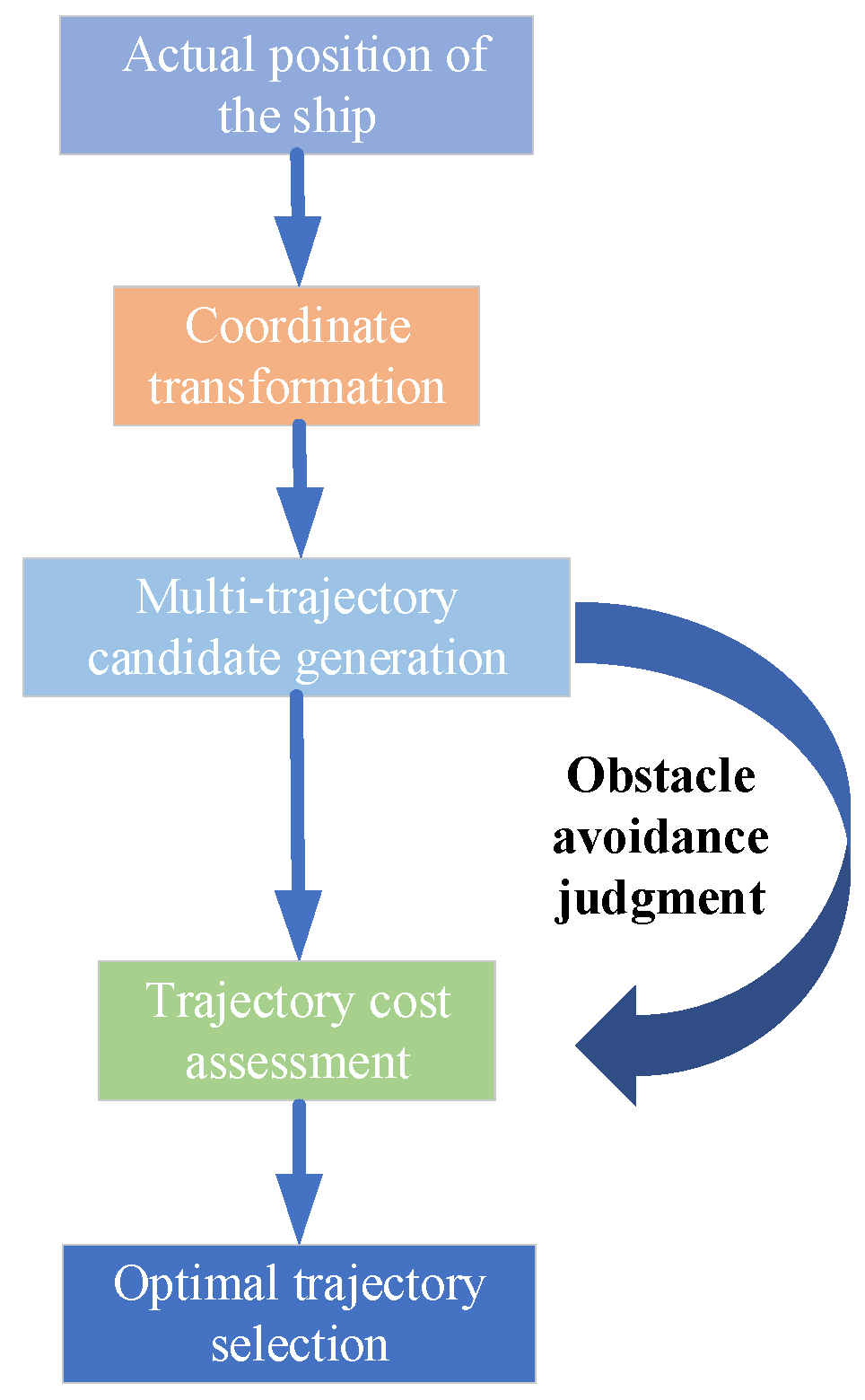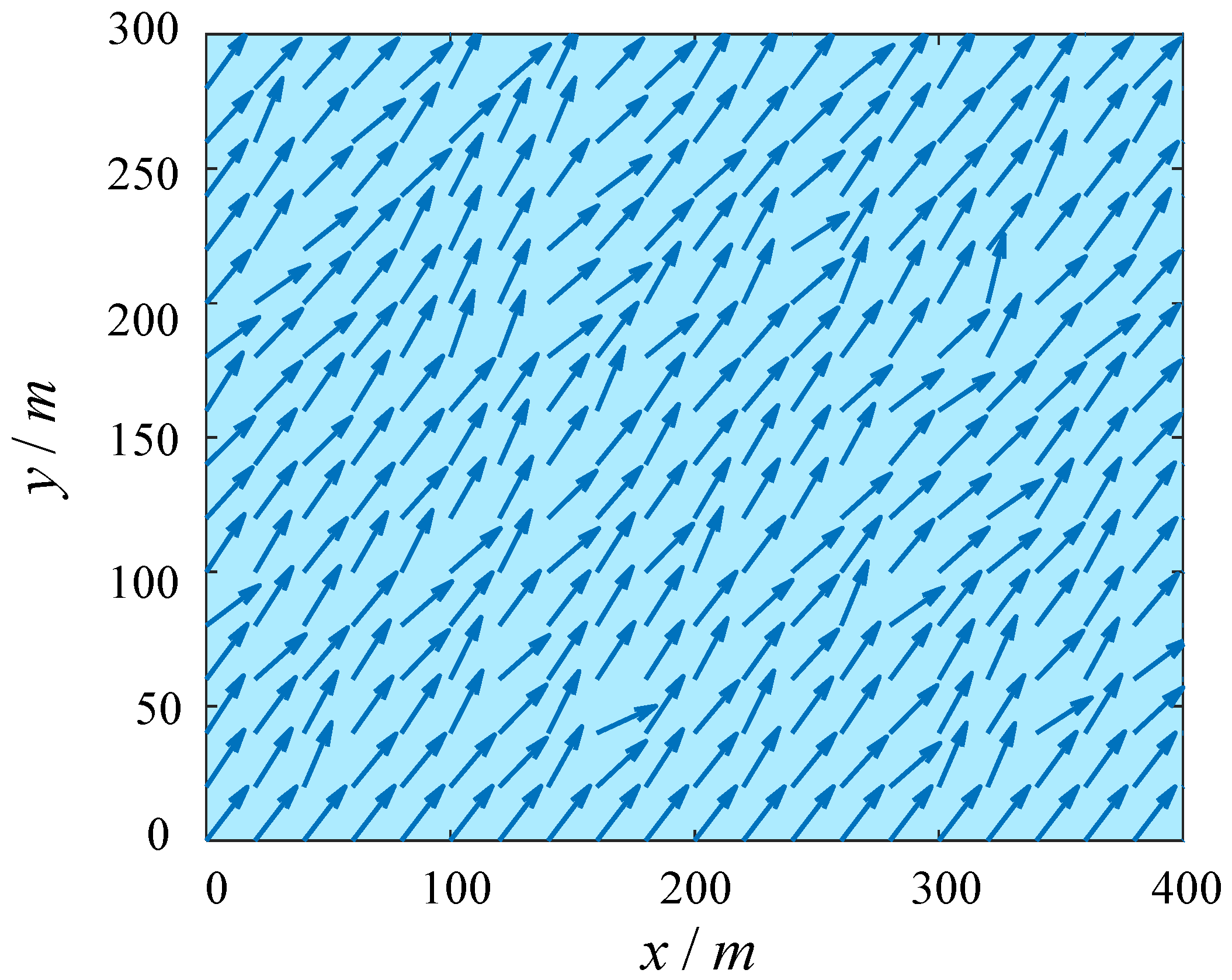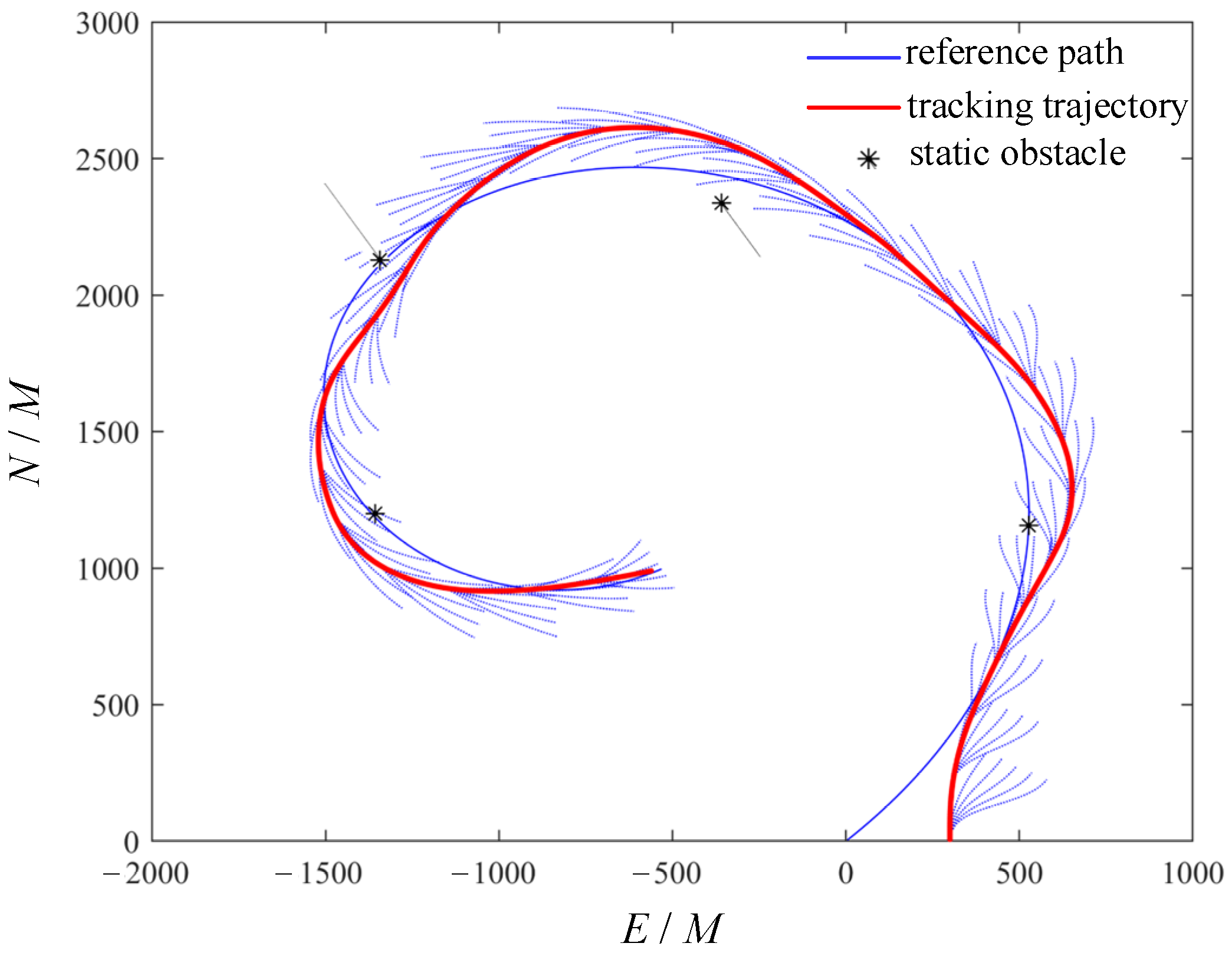1. Introduction
With the growing demand for maritime trade, the marine transportation industry has flourished. The underactuated surface vehicle (USV) plays an indispensable role in the transport industry; therefore, the USV control problem has received widespread attention [
1,
2]. Among the solutions, trajectory-tracking control is an essential research direction in the area of ship control, which not only helps to promote the development of ship intelligence and automation but also reduces ship operating costs and improves ship navigation safety [
3].
For the target-tracking problem of underpowered ships, Wang [
4] designed a fixed-time predictor to approximate the side slip caused by interference. And the Line-of-Sight method is utilized to design a fixed-time heading controller to ensure the stability of the heading and achieve accurate path tracking. Yang [
5] transformed the path-tracking problem into the stabilization problem of longitudinal velocity and yaw angle by the Line-of-Sight method, and they combined a neural network and the sliding method to design a neural sliding mode robust controller, which realized the tracking control of an underactuated ship. Although neural networks have powerful nonlinear approximation capabilities, their training process may require a large amount of data and time, and there may be problems such as overfitting. Su [
6] improved the integral Line-of-Sight method by introducing the concept of a vector field into the curved path, achieving the goal of effectively tracking dynamic objects on the water surface for underactuated surface vehicles. However, the Line-of-Sight method cannot converge the controlled object to the desired path and there is steady-state position error. To address this issue, Zhang [
7] proposed an adaptive, hyperbolic tangent, Line-of-Sight method control strategy based on the hyperbolic tangent function. The hyperbolic tangent function was used to correct the expected bow curve flatness, further improving the tracking accuracy and convergence performance. However, none of the above studies took into account the issue of external perturbation.
Since underdriven ships have dynamic instability as well as unknown time-varying perturbation problems, references [
8,
9] redesigned the interference observer to provide an estimated value of the interference when it is unknown. Combined with dynamic inverse control technology, the robust trajectory-tracking control rate is calculated to enhance the anti-interference capability of underactuated ships. However, the above-mentioned research failed to take into account the frequent update of the controller when considering external disturbances, which may lead to severe wear of the steering gear. To address this issue, Song [
10] designed an event-triggered adaptive sliding mode controller. By introducing an event-triggered mechanism, the system’s immunity to interference is significantly improved, while the frequency of controller updates is further minimized. However, in this study, the static thresholds T
1 and T
2 in the event-triggering conditions are fixed values, and the dynamic influence of the ship’s navigation state (such as speed and heading change rate) on the thresholds is not considered. This may lead to a decrease in control accuracy or an excessive number of updates under certain working conditions. Zhou [
11] proposed a trajectory-tracking control strategy based on deep reinforcement learning. This method develops a controller based on the mixed-priority dual-delay deep deterministic policy gradient (TD3), integrates the mixed-priority experience replay (HPER) mechanism, and further accelerates the convergence of the network. Judging from its simulation results, this method has s strong anti-interference ability in complex marine environments. The above studies are unable to converge the error state to 0 or a nearby field in a finite amount of time, thus making it difficult to meet the needs of ships for precise tracking and control tasks.
In response to the above issues, Wang [
12] proposed an event-triggered, robust, adaptive, finite-time, trajectory-tracking control scheme. While improving the control accuracy, this ensures the safe and efficient completion of the tracking task. Li [
13] proposed a trajectory-tracking control strategy for a USV with a disturbance compensation observer, which can accurately compensate for disturbances within a limited time. Zeng [
14] proposed a new finite-time control law based on the backstepping method and additive power integration method. The controller ensures that the trajectory-tracking error of the surface vessel converges to the neighborhood near the origin within a finite time through continuous feedback. However, in practical applications, if the system model differs significantly from the actual situation, it may affect the control effect.
The above-mentioned research has solved problems such as handling external interference and error convergence, but the load on its controller is relatively large. Shen [
15] proposed a minimum-parameter, adaptive, recursive, sliding-mode control strategy based on the time-varying, asymmetric obstacle Lyapunov function to address this issue. Minimum-parameter method neural network approximation of model uncertainty is utilized to reduce the computational complexity. Meanwhile, the command filter is adopted to constrain the amplitude of the input signal, to avoid the problem of differential explosion. Wang [
16] suggested a nonlinear, robust, trajectory-tracking control method by combining the inverse step method as well as adaptive techniques. The dynamic surface method is utilized to directly derive the derivatives of the variables, thus effectively reducing the complexity of virtual variable derivation in the traditional algorithm. However, the real-time obstacle avoidance problem was not considered in the research.
As can be seen from
Table 1 below, none of the above studies took into account the real-time obstacle avoidance problem of underactuated ships. Based on the above incentives, this paper makes the following contributions:
- (1)
The equal-radius circular-arc steering control methodology proposed in this paper avoids the issue of overshoot or undershoot caused by the large turning radius.
- (2)
The dynamic virtual ship group methodology suggested in this paper can update the coordinates and bow angles of virtual ships in real time to plan an optimal obstacle avoidance path.
- (3)
The EKF algorithm can continuously correct the state estimates to further reduce the estimation error and ensure the control accuracy of the system.
The other parts of this article are organized as follows.
Section 2 presents the ship control strategy, including the equal-radius circular-arc steering maneuver, Cartesian coordinates and Freightliner coordinates, and virtual ship group control methods;
Section 3 introduces the model predictive control scheme;
Section 4 presents simulation experiments to verify the anti-interference ability and obstacle avoidance function of the system; and
Section 5 presents the conclusion and outlook.
3. Model Predictive Control Scheme
The Nomoto model is applicable to the approximate description of the motion characteristics of ships and can be used for the dynamic response simulation of path-tracking control [
20]. Therefore, this paper selects the Nomoto ship motion model for further research. The model is constructed as shown in Equation (9):
where
stands for the transfer function mathematical model, and
represents the ship range and rudder angle. MPC is a discrete model-based control method, and to reduce the computational effort of subsequent constraintization, Equation (9) needs to be discretized into a differential, integrated, moving-average autoregressive (CARIMA) model, which then captures most of the properties of the transfer function model. This paper takes the “Yukun” ship as the research object, and it discretizes its Nomoto mathematical model to obtain the CARIMA mathematical model as follows:
in which
,
,
is the bow output of the
step,
is the rudder angle of the
step,
denotes the unknown zero-mean value of the environmental interference and measurement noise,
stands for the difference operator, and
is the filter, which is the mechanism for adjusting the sensitivity of the loop about
. Its specific value is
.
If the noise and interference are well suppressed by the compensation mechanism, let
, expanding
(as an example of expanding by 4 steps), which yields
The above equation can be organized as
in which
and
represent the predicted time-domain variables and past variables, respectively,
and
represent the
and
Toplitz matrices, respectively, and
and
are the Hankel matrices for
and
, respectively.
To further enhance the control accuracy of the system, the Extended Kalman Filter (EKF) algorithm is added to the control system. EKF takes the current state estimation of the MPC algorithm as the control input. By constantly updating the state estimation, it predicts the state at the next moment, thereby estimating the state of the ship more accurately. Equation (14) shows the state prediction step of the EKF algorithm at moment
:
in which
stands for the state prediction value at the moment
;
is the state transfer Jacobi matrix;
is the prediction covariance matrix; and
is the process noise covariance matrix. Among them, the
matrix is shown as Equation (15).
where
,
,
,
, and
denote the process noise variance of position
, position
, velocity
, heading angle
, and yaw rate
, respectively.
The EKF algorithm performs a state update step after predicting the state in the next moment, taking into account the actual measured data as well as the predicted state. Equation (16) shows the state update step of the EKF algorithm at moment
:
in which
stands for the measurement residual;
stands for the measurement Jacobi matrix;
stands for the measurement covariance matrix;
stands for the Kalman gain; and
stands for the measurement noise covariance matrix, as shown in Equation (17).
where
,
,
,
, and
denote the measurement noise variance of position
, position
, velocity
, heading angle
, and yaw rate
, respectively.
The EKF algorithm feeds the computed state estimates back into the MPC algorithm again to further update the state variables of the MPC algorithm. This step ensures that the state variables of the MPC are always the estimated values corrected by the EKF, thus enhancing the accuracy and robustness of the system. Equation (18) represents the latest bow output at the moment of
, where
and
.
In the control system, the state error is the error between the current state and the expected state, which is utilized to measure the tracking performance of the system. Its specific calculation is shown in Equation (19), where
represents the expected output of the system at the
moment, and
represents the predicted output at the
moment.
Establish the following quadratic indicators:
where
is the rudder angle change at the
step. Among them,
is a regularization parameter used to balance the state error and control the energy of the input. When substituting
in Equation (18), the following can be obtained:
By analyzing the above equation, it can be concluded that only the terms related to
are operable in the control. Therefore, the optimization problem can be established as
in which
stands for the selection matrix of the predictor variables, and
is the constant matrix containing the upper- and lower-bound constraints
and
. The above equation is a quadratic programming issue, and the result can be addressed based on the interior point method encapsulated in MATLAB R2023b.
Assume that there exists a feasible optimal control sequence
in the initial state
, corresponding to the state response sequence
. Therefore, the corresponding control term of this control sequence
continues to be used at
, resulting in
. The optimal performance indicators at the initial moment and the optimal performance indicators at the next moment are shown in Equation (23).
By comparing these two performance indicators, it can be obtained that
From the above formula, it can be seen that the performance indicators of the system monotonically decrease, thereby proving the stability of the system.
Summary of this section: In the actual navigation process of a ship, its real-state information is input into the Extended Kalman Filter (EKF) module. Through state prediction and update steps, environmental disturbances and measurement noises are filtered out, thereby obtaining optimized state estimates. The state estimates corrected by the EKF are used as inputs to the model predictive control (MPC). Combined with the discretized CARIMA ship model, a sequence of future states is generated within the prediction horizon. Subsequently, MPC solves the optimal control sequence based on state errors and a quadratic cost function, and it outputs the first-step rudder angle command to act on the ship. The new state of the ship after executing the control command is fed back to the EKF again, forming a closed-loop data flow of “measurement—filtering—prediction—control”, which ultimately achieves high-precision trajectory tracking and improved robustness. This data flow architecture, through the dynamic coupling of EKF and MPC, not only ensures the accuracy of state estimation but also enhances the adaptability of control decisions to model errors and external disturbances.
Remark 2. Incorporating the EKF algorithm into the MPC algorithm can realize the function of fast real-time updating of the ship state estimation, which enables the system to respond to the changes in the ship state in a timely manner, and it ensures the maneuverability of the ship as well as the safety of navigation in the complex environment.
4. Experimental Simulation
To verify the anti-interference of the control method proposed, level 6 wind and wave disturbances are included in the simulation experiments.
Figure 6 and
Figure 7 are the simulation result diagrams of the wind field and wave field introduced in this experiment [
21]. The direction of the blue arrow in
Figure 6 indicates the flow direction of the wind. The parameters of this wind farm are set as follows: average wind speed 10 m/s, wind direction angle 30°. The wave field parameters are as follows: The effective wave height is approximately 2.5 m, the wave period is between 6 and 10 s, and the wave direction is random. The wave spectrum adopts the Pierson–Moskowitz model, in which the peak frequency of the spectrum is 0.1 Hz and the spectrum width is 0.05 Hz.
This experiment takes the “Yukun” ship as the research object to carry out simulation experiments. The specific parameters of the model are shown in the following
Table 2 [
22].
This paper adopts the Legion R7000 ARP8 device for simulation experiments. The processor of this device is “AMD Ryzen 7 7735H with Radeon Graphics 3.20 GHz”. The simulation software used is MATLAB R2023b.
In this experiment, a reference path is generated using the cubic spiral curve function, and static obstacles as well as dynamic obstacles are added to the path to further validate the algorithm’s obstacle avoidance function in complex environments. The obstacle avoidance effect is shown in
Figure 8. The star points represent the obstacles, and the star points with moving trajectories represent the dynamic obstacles. The position information of the four obstacles a, b, c, and d in sequence is [810, 2516, 0, 0], [−700, 3800, 0.75, 120 * pi/180], [−2500, 4000, 0.4300 * pi/180], and [−2163, 2000, 0, 0]. The first two elements represent the initial horizontal and vertical coordinates of the obstacle, and the last two elements represent the speed and direction of the obstacle. The blue line represents the original planned route, the red represents the tracking trajectory, and the dashed lines represent the planned path branches. This experiment was set up with a ship speed of 13 knots and a sampling rate of 1 Hz.
The system causes the ship to perform approach behavior and perform tracking functions based on a reference path. While traveling, when the system detects an obstacle entering the capture distance, it can pre-generate five path branches based on the location of the obstacle. And a cost function is calculated for each obstacle with respect to the real-time position of the ship, which is added to the total planning cost. Subsequently, the system selects one of the paths with the smallest total cost as the optimal obstacle avoidance path. And so on until the ship reaches the final position of the target reference path.
From the above figure, it can be seen that the ship model can still safely avoid obstacles and travel normally under the interference of 6 level wind and waves. And it can execute a trajectory-tracking decision quickly after successful obstacle avoidance, close to the original reference path.
As shown in
Figure 9, the rudder angle output of the algorithm proposed in this paper is plotted when performing trajectory tracking as well as obstacle avoidance tasks, where the red line represents the rudder angle output value of the original MPC algorithm, the green line represents the rudder angle output value of the nonlinear feedback control algorithm, pink represents the rudder angle output graph of the Line of-Sight method, and the blue line represents the rudder angle output value of the improved MPC. It can be clearly seen from the above figure that the improved model predictive control algorithm, compared with the other two algorithms, not only accurately completes the track tracking and obstacle avoidance tasks but also further reduces the motion amplitude of the ship model, avoiding problems such as energy loss and mechanical wear caused by an excessive output rudder angle.
Table 3 shows a comparison of rudder angle outputs between the original MPC algorithm and the improved MPC algorithm under sea conditions of level 6. Compared with the nonlinear feedback control algorithm, the improved MPC algorithm reduces the maximum rudder angle output value by 58%, the integral absolute error by 34%, and the root mean square error value by 36%. Compared with the Line-of-Sight (LOS) algorithm, the improved MPC algorithm still has a better control performance. The maximum rudder angle output value was reduced by 32%, the integral absolute error was reduced by 45%, and the root mean square error was reduced by 48%. Compared with the original MPC algorithm, the improved MPC algorithm reduces the maximum rudder angle output value by 58%, the integral absolute error by 46%, and the root mean square error value by 46%. Thus, the algorithm suggested in this paper can ensure that the ship accurately performs the trajectory tracking and obstacle avoidance tasks under adverse sea conditions, as well as further reduce mechanical wear and tear.
To further analyze the tracking performance of the algorithm proposed in this paper and the nonlinear feedback control algorithm,
Figure 9 presents the convergence curves of position errors under the two control laws. The calculation of the position tracking error is shown in Equation (25).
As can be seen from
Figure 10, compared with the nonlinear control algorithm and the LOS algorithm, the position error under the improved MPC control law is smaller and can effectively track the reference path. Meanwhile, the improved MPC control law has a relatively fast convergence speed, which can respond promptly and adjust the control input to reduce offset.
To ensure the statistical reliability of the experimental results, this paper conducted 10 independent repeated tests for the same scenario (including sea conditions of level 6). The final result shows a high degree of consistency. Therefore, the proposed algorithm has a stable performance in complex sea conditions and the results are reproducible.
This subsection verifies the validity of the proposed method through the above simulation experiments, while all the verifications are carried out in the simulation environment. In the future, an experimental platform will be set up to test the hardware and validate the proposed method in real scenarios using the Yukun ship as the experimental object.
5. Conclusions
To solve the overshoot problem caused by an excessive turning radius when ships turn, an equal-radius-arc turning maneuver method is proposed. Based on the model predictive control algorithm, a virtual ship group control method was proposed, and a hierarchical weighting function was established to process the state information of virtual ships, thereby effectively implementing collision avoidance decisions. Meanwhile, the Extended Kalman Filtering algorithm is introduced. By continuously performing the prediction and update steps, the control accuracy of the system is further improved. It can be seen from the simulation results that the method proposed in this paper can still accurately perform the tracking task and safely avoid obstacles under the interference of wind waves of level 6, and it has a strong anti-interference ability and obstacle avoidance function. While ensuring safe operation, we must further reduce the rudder angle output value to avoid excessive energy consumption and mechanical wear problems.
Subsequently, the author will integrate real sensors to verify the performance of complex, dynamic-obstacle recognition and obstacle avoidance, and conduct real-ship experiments on the “Yukun” vessel to verify the stability of the steering control method and the real-time performance of the control strategy, as well as the adaptability of the extended algorithm in high-flow waters.
